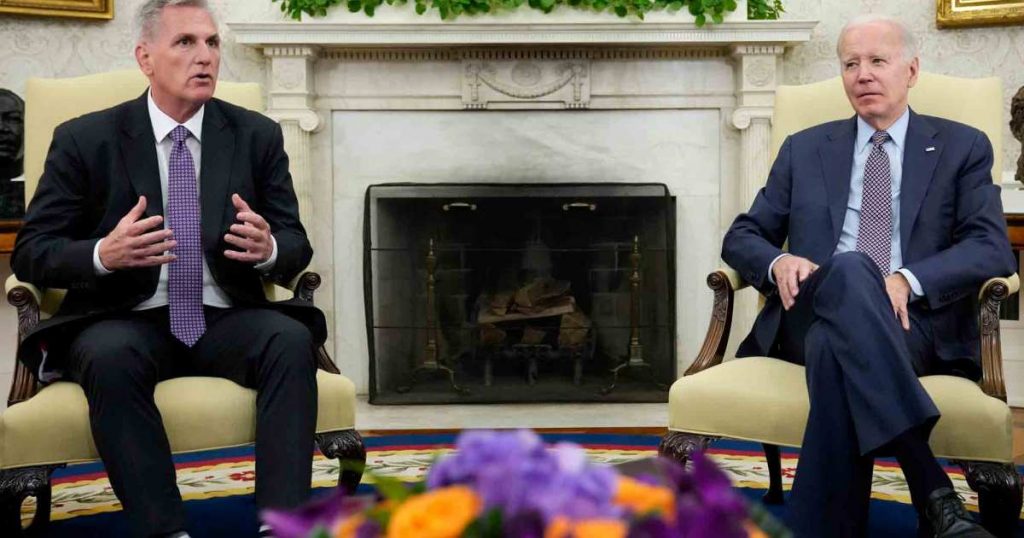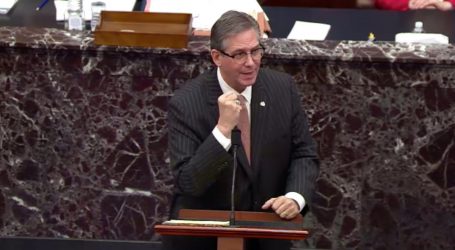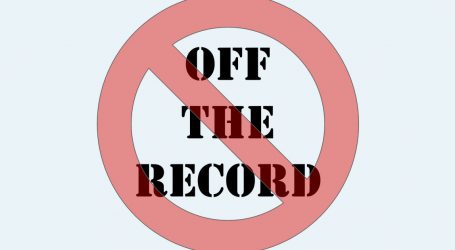How the Media Aid and Abet GOP Hostage-Takers
House Speaker Kevin McCarthy meets with President Joe Biden in the Oval Office to discuss the debt limit on May 22, 2023.Alex Brandon/AP
Editor’s note: The below article is a preview of the lead item in the next edition of David Corn’s newsletter, Our Land. The newsletter comes out twice a week (most of the time) and provides behind-the-scenes stories and articles about politics, media, and culture. Subscribing costs just $5 a month—but you can sign up for a free 30-day trial of Our Land here. Please check it out.
Imagine I come home and find a crazy man in my house. He is holding a full gas can and a lit match. “If you don’t sign over the deed to your house,” he screams, “I will burn this place down.” I refuse, and we enter a standoff for days. Neighbors gather around my home. The police arrive. It is a major scene. The media show up. The newspaper and TV reporters see this as a big story and slap it on the front page and lead the evening news with it: “Two local residents caught in fierce negotiations. If their talks don’t succeed, a house will go up in flames.”
That seems to be the general media framing of the debt ceiling debate in Washington, DC. In horse-race style, much of the press has covered this episode as a political battle of two opposing forces: President Joe Biden and House Speaker Kevin McCarthy. And there’s been much breathless and up-to-the-minute reporting of the ins-and-outs of the deliberations between the White House and the House Republicans, with each side treated as equal partners in this tale of high-stakes politics.
Earlier this week, the New York Times front-paged a report on how McCarthy was “attempting a difficult balancing act” in the negotiations, trying to cobble together a budget deal that would win enough Republicans without alienating the most extremist members of his caucus, who—thanks to the agreement that landed McCarthy in the top House post—could easily boot him out of the speakership. Meanwhile, Politico focused on Biden’s negotiating stance, noting he has “prioritized deal-making through much of the debt ceiling talks, laboring to work across the aisle even at the risk of alienating the liberal wing of his own party.”
There was nothing wrong with these stories in and of themselves, but this coverage underplayed the core element of the story: GOP radicals, by refusing to sign off on raising the debt ceiling so the US government could pay bills already accrued (many of which were the results of what Congress voted for), were threatening to trigger a financial crisis and blow up the US economy.
The lead of the Politico article did convey the danger at hand: “The nation stands on the precipice of an unprecedented financial calamity, testing whether the president’s theory of governance can continue to work.” But it did not attribute responsibility for this potential crisis. And it seemed to suggest that Biden would be to blame for this catastrophe—if his theory were crap.
Much of the media has dutifully reported on the disasters likely to occur if the US government defaults on its debt. NPR noted the S&P could plummet by 20 percent, interest rates could soar, and a recession could strike. CBS News reported that financial markets could be in chaos, Social Security checks delayed, Medicaid and Medicare disrupted, and the housing market frozen. The Economist pointed out that “a surge in unemployment” and “panic throughout the global economy” were possible. The New York Times published an explainer that detailed a variety of catastrophes that could ensue.
But none of these stories highlighted the culprit responsible for the doomcasting: the House Republicans. They described the horrific consequences of a default as one would those of a hurricane or some other natural disaster. Yet in this case, the potential destruction is clearly human-made—and teed up by a particular set of humans.
Both-sidesism is deeply ingrained within political journalism. Though Donald Trump has pushed mainstream outlets to reconsider this approach—after all, only one side attempted to overturn an election and incite a violent insurrectionist assault on the US Congress—it remains the default position. (Pun intended.) Consequently, the to-default-or-not-default drama is depicted as a face-off between two political factions, not as an act of political terrorism mounted by a band of extremists. Where is CNN’s Countdown to the Disastrous GOP Default Clock? (The network is certainly not going to do that these days, now that it has pivoted toward a more chummy relationship with the Rs.)
Earlier this week, Jonathan Weisman, a savvy political reporter for the New York Times, tweeted, “From my experience w/ past debt limits, @SpeakerMcCarthy’s problem & the nation’s is a huge chunk of the GOP doesn’t believe a default will cause any problems. They think it’s all liberal claptrap. They want their cuts & they don’t care about consequences.”
That’s true. But shouldn’t that be the dominant story of the moment? Ignorant and cavalier Republicans threaten to cause economic meltdown. And does this problem arise in part because this crisis is mostly presented as two-sided budget negotiations and not as the (nightmare) tale of one extremist party playing chicken with the economy? The Republicans even admit that’s their game. Rep. Matt Gaetz (R-Fla.) has openly described the GOP strategy as hostage-taking. Proclaiming support for the GOP measure that tied raising the debt ceiling to spending cuts that would hurt low-income Americans, he said, “I think my conservative colleagues for the most part support Limit, Save, Grow, and they don’t feel like we should negotiate with our hostage.”
Of course, it’s not entirely the media’s fault. The Biden White House tried and failed to establish GOP recklessness as the dominant narrative. President Biden initially declared he would not negotiate with these terrorists. But then he did, and the White House messaging operation failed in pinning the blame for the crisis squarely on the Republicans. Should the sh*t hit the fan, there was no telling who would be seen as more at fault by the public—Biden or the Republicans. This open question and Biden’s sense of responsibility brought him to the negotiating table.
As of Friday morning, it seemed a deal to avert a default might be within reach. It could well entail budget cuts that impact government programs for middle- and low-income Americans. The GOP position literally was this: We will allow the US government to pay its bills—which includes those run up by the Trump administration and a Republican Congress—and avoid an economic calamity, if you stick it to Americans who need help.
Yet whatever the outcome, the point remains: The Republican assault on rational governance—and the party’s penchant for chaos and destruction—was not sufficiently emphasized within the political media. This strengthened the hand of the hostage-takers in this episode and showed them that they can engage in political terrorism with little cost. What might that mean for the future?





